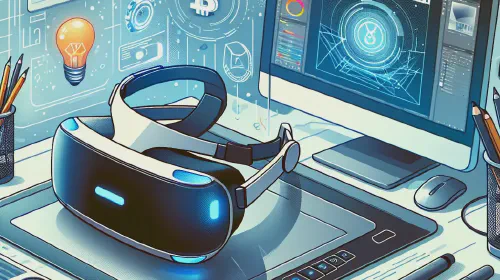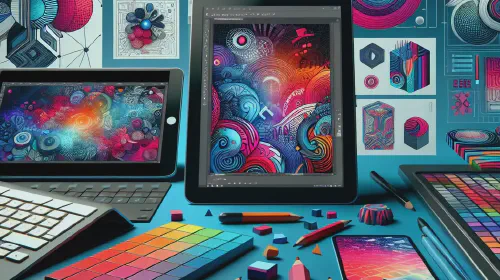The World of Digital Art - Categories and Techniques
Salomon Kisters
Dec 28, 2023This post may contain affiliate links. If you use these links to buy something we may earn a commission. Thanks!
Digital art is a broad field where artists use digital technology in creating or presenting their work. As technology evolves, digital art keeps growing, presenting new ways to express and interact.
In this article, we will have examine different categories of digital art along with their associated technologies to guide you through this expanding sector of art.
Categories of Digital Art
Digital art encompasses a wide range of artistic works that utilize digital technology as an integral part of the creation or presentation process. As technology advances, the boundaries of digital art continue to expand, offering new forms of expression and interaction. Below are some of the categories of digital art that have emerged over the years.
Computer-Generated Visual Media
Computer-Generated Visual Media, often known as CGI (Computer-Generated Imagery), is the art of creating visual content with the help of computer software. This category includes both still images and animations that are generated entirely through digital means.
CGI is widely used in various industries, including film, television, video games, and virtual reality, to create realistic or fantastical scenes that would be difficult or impossible to capture with traditional photography or videography.
CGI can be further divided into 3D modeling, where objects are created in a three-dimensional space, and 2D digital painting, where artists use software to simulate traditional painting techniques. Innovations in CGI have led to the development of virtual reality (VR) and augmented reality (AR), which offer immersive experiences by blending the digital and physical worlds.
Digital Photography
Transitioning from CGI to another prevalent form of digital art, we encounter Digital Photography. This refers to the process of capturing images using digital cameras or other electronic devices, which can then be edited, shared, and printed using computers. Unlike traditional film photography, digital photography provides instant feedback through the camera’s display and allows for greater flexibility in post-processing.
The advantages of digital photography include the ability to store thousands of images on a single memory card, share photos instantly over the internet, and utilize a wide range of software to enhance or alter images. Digital photography has democratized the field of photography, making it more accessible to amateurs and professionals alike. It spans various genres, from portrait and landscape photography to photojournalism and fine art photography.
Digital Installation Art
Another intriguing category is Digital Installation Art, an interactive genre that combines digital technology with the concept of installation art to create immersive environments. These installations often involve video, sound, light, and other multimedia elements that respond to the presence or actions of the viewer. The goal is to create a unified experience that transforms the perception of space and encourages audience participation.
Artists working in this field experiment with various forms of digital expression, including projection mapping, interactive sculptures, and sensor-based environments. Digital installations can be found in art galleries, public spaces, and at festivals, where they offer a multi-sensory experience that blurs the line between the artwork and the audience. This form of art challenges traditional notions of art as a static object and instead presents it as a dynamic and evolving encounter.
These categories represent just a glimpse into the diverse world of digital art, which continues to evolve with technological advancements and creative exploration.
Techniques and Tools in Digital Art Creation
Techniques for Computer-Generated Visual Media
Delving deeper into the techniques behind CGI, we find that artists employ a variety of methods to bring their visions to life. Digital painting, for example, can be done using software like Corel Painter, which allows artists to simulate traditional painting techniques with digital tools. For animation and visual effects (VFX), artists often use rendering and compositing techniques to create realistic or fantastical scenes.
These techniques are not limited to entertainment but are also used in creating visualizations for various industries.
Tools for Digital Photography
Essential tools for digital photographers include:
- Cameras: The most fundamental tool for any photographer, with options ranging from DSLRs to mirrorless systems.
- Photo Editing Software: Adobe Lightroom and Photoshop are industry standards for photo editing, offering a wide range of tools for image correction and manipulation.
- AI Software: Tools like Topaz Labs AI Bundle leverage artificial intelligence to enhance photos and perform tasks like noise reduction and sharpening.
- Color Calibration: Devices like the X-Rite ColorChecker Passport Photo ensure accurate color reproduction from capture to print.
- Accessories: Tripods, memory cards, and instant printers like the Lifeprint are also crucial for capturing and sharing high-quality images.
Techniques and Tools for Digital Installation Art
When it comes to digital installation art, artists like Morehshin Allahyari use a variety of media, including sculpture, 3D printing, and sound, to explore the intersection of technology and art. Techniques can involve creative computing, which uses computer science to create interactive installations and digital sculptures. The tools for creating digital installation art are diverse, ranging from software for developing concepts to hardware for constructing site-specific projects.
The impact of material and technique upon form and content is a critical consideration in digital installation art, as it shapes the way audiences interact with and interpret the work.
By blending modern digital tools with traditional techniques, digital artists are able to push the boundaries of creativity and explore new realms of artistic expression. Whether through CGI, digital photography, or installation art, the fusion of technology and art continues to evolve and inspire.
Conclusion: The Expanding Universe of Digital Art
As we conclude our exploration of digital art, it is clear that this field is not just about the end product but also about the process, the techniques, and the tools that make it all possible. The categories we’ve discussed�computer-generated visual media, digital photography, and digital installation art represent just a fraction of the digital art spectrum.
Each category is rich with its own set of practices and equipment, allowing artists to convey their unique visions in ways that were once unimaginable. The digital art landscape is a testament to human ingenuity and the power of innovation, continually being reshaped by the artists who dare to envision and create. As technology marches forward, so too will the art that it helps to birth, ensuring that the world of digital art remains a dynamic and inspiring field for years to come.
Stay informed with the latest insights in Crypto, Blockchain, and Cyber-Security! Subscribe to our newsletter now to receive exclusive updates, expert analyses, and current developments directly to your inbox. Don't miss the opportunity to expand your knowledge and stay up-to-date.
Love what you're reading? Subscribe for top stories in Crypto, Blockchain, and Cyber-Security. Stay informed with exclusive updates.
Please note that the Content may have been generated with the Help of AI. The editorial content of OriginStamp AG does not constitute a recommendation for investment or purchase advice. In principle, an investment can also lead to a total loss. Therefore, please seek advice before making an investment decision.

Digital Art in the Commercial Sphere: Applications and Careers
Learn about the applications and careers in digital art within the commercial sector, focusing on branding, advertising, and user experiences. Explore the diverse opportunities in this dynamic field.

Understanding Digital Art - Forms and Styles
Explore the vibrant realm of digital art and its fusion with technology. Discover the diverse styles and innovative potential that redefine artistic expression in the digital age.

The Evolution of Digital Payments: A Timeline
Explore the fascinating journey of digital payments through time with our detailed timeline. Trace the evolution of this modern convenience from its humble beginnings to the widespread advancements of today, and see how far we've come.
Protect your documents
Your gateway to unforgeable data. Imprint the authenticity of your information with our blockchain timestamp